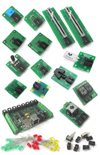 You’ve probably heard of them already, but in case you haven’t, Thermaltake has a great selection of DIY components for liquid cooling of computers and similar products. They offer both passive and active radiator solutions, plus various ways to cool CPUs, memory, video cards, etc. Pretty extensive. It does seem geared more towards the DIY rather than OEM; if you’re designing such a system for an OEM I recommend you also check out CoolIT; they have some very high quality products and are a good fit for production systems (Thermaltake may be as well, I just haven’t seen their products up close yet).
You’ve probably heard of them already, but in case you haven’t, Thermaltake has a great selection of DIY components for liquid cooling of computers and similar products. They offer both passive and active radiator solutions, plus various ways to cool CPUs, memory, video cards, etc. Pretty extensive. It does seem geared more towards the DIY rather than OEM; if you’re designing such a system for an OEM I recommend you also check out CoolIT; they have some very high quality products and are a good fit for production systems (Thermaltake may be as well, I just haven’t seen their products up close yet).
Author Archives: Matt
The OpenCoffee Club
Hey all you entrepreneurs, check out the OpenCoffee Club! It combines two of my favorite things, expresso and startups! The OpenCoffee Club was founded to establish regular meeting places where investors and entrepreneurs can meet in an informal setting. It’s great for networking, getting advice, or possibly even get funding for your latest hair-brained scheme! It’s still growing, and as such locations are limited, but go check it out here.
Don’t screw it in, SNAP it in instead!
 A German company, Dirak, has taken an unusual approach to sheetmetal assembly. They’ve worked out a system for literally snapping components in place rather than using screws. This system is being used on everything from latches to handles and even hinges. The advantages are fairly obvious, mainly, lower assembly cost. However, this will be offset somewhat by an expected higher unit cost. Still, it’s an interesting approach. Check it out here. (via Design News)
A German company, Dirak, has taken an unusual approach to sheetmetal assembly. They’ve worked out a system for literally snapping components in place rather than using screws. This system is being used on everything from latches to handles and even hinges. The advantages are fairly obvious, mainly, lower assembly cost. However, this will be offset somewhat by an expected higher unit cost. Still, it’s an interesting approach. Check it out here. (via Design News)
Phidgets
 Engineers who like to tinker around with electronics projects may be interested in Phidgets, a neat modular approach to device interactivity. It’s basically a system for using a USB interface to read data from a huge variety of sensors: touch, sliding, force, light, rotation, magnetic, vibration, temperature, RFID, etc – in other words, any type of physical input can easily be detected and used by a computer for whatever purposes the engineer can dream up. Naturally, software tools are included to help integrate these sensors into that world-conquering robot you’ve always wanted to design. Prices are quite reasonable, too.
Engineers who like to tinker around with electronics projects may be interested in Phidgets, a neat modular approach to device interactivity. It’s basically a system for using a USB interface to read data from a huge variety of sensors: touch, sliding, force, light, rotation, magnetic, vibration, temperature, RFID, etc – in other words, any type of physical input can easily be detected and used by a computer for whatever purposes the engineer can dream up. Naturally, software tools are included to help integrate these sensors into that world-conquering robot you’ve always wanted to design. Prices are quite reasonable, too.